Abstract
There are often large strain differences in the response of laboratory animals to toxic chemicals and carcinogens, with some strains being totally resistant to dose levels that cause acute toxicity and/or cancer in other strains. The current National Toxicology Program carcinogenesis bioassay (NTP-CB) uses only a single isogenic strain of mice and rats and may therefore miss some carcinogens. New short-term tests to predict mutagenesis and possible carcinogenesis are validated using data from the NTP-CB. If the animal data are inaccurate, it may hinder this validation. The accuracy of the NTP-CB could be improved by using two or more strains of each species without increasing the total number of animals. It would be possible to continue to use sample sizes of 48-50 animals, but subdivide these into groups of 12 animals of 4 different strains (48 animals total) per dose/sex group, for example, instead of 48 identical animals. This would quadruple the number of genotypes without any substantial increase in cost. Such a multistrain "factorial" design would, on average, be statistically more powerful then the present design and should increase the chance of detecting carcinogens that currently may give equivocal results or go undetected because the test animal strains happen to be specifically resistant. When strains differ in response, studies of differences in metabolism, pharmacokinetics, DNA damage/repair, cellular responses, and in some cases identification of genetic loci governing sensitivity may provide biological information on toxic mechanisms that would help in assessing human risk and setting permissible exposure limits. The NTP may have made the world a safer place for F344 rats and B6C3F1 mice.(ABSTRACT TRUNCATED AT 250 WORDS)
Full text
PDF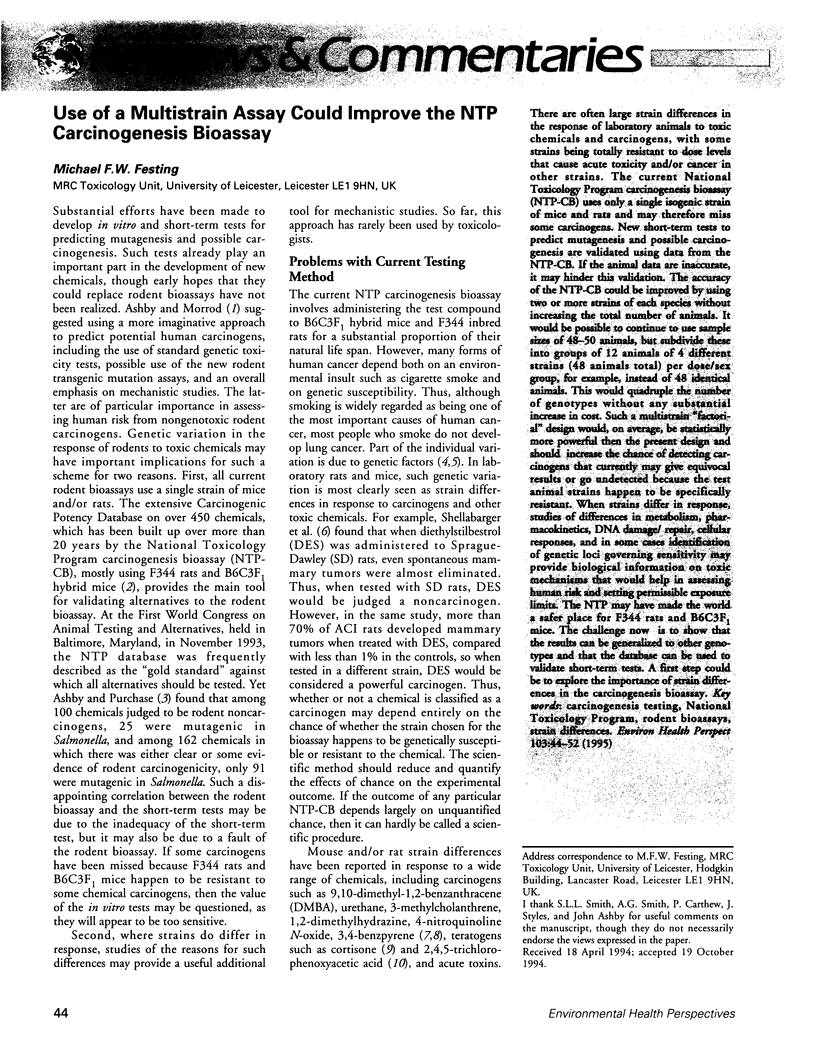
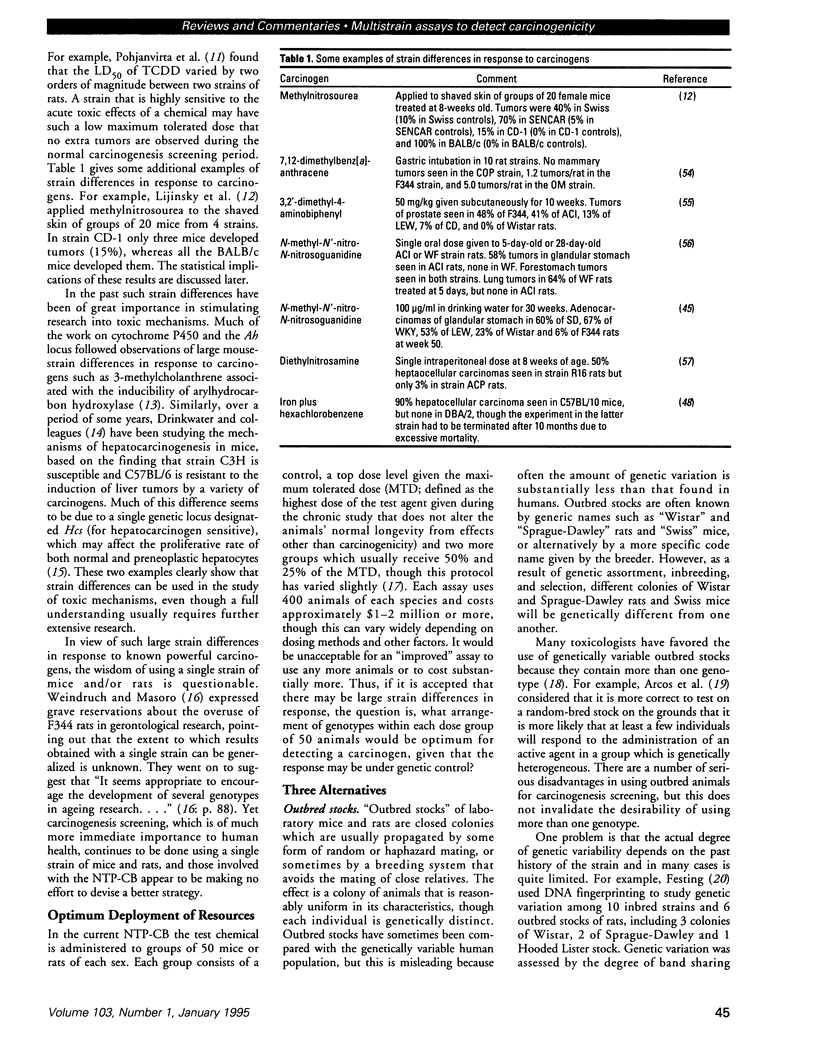
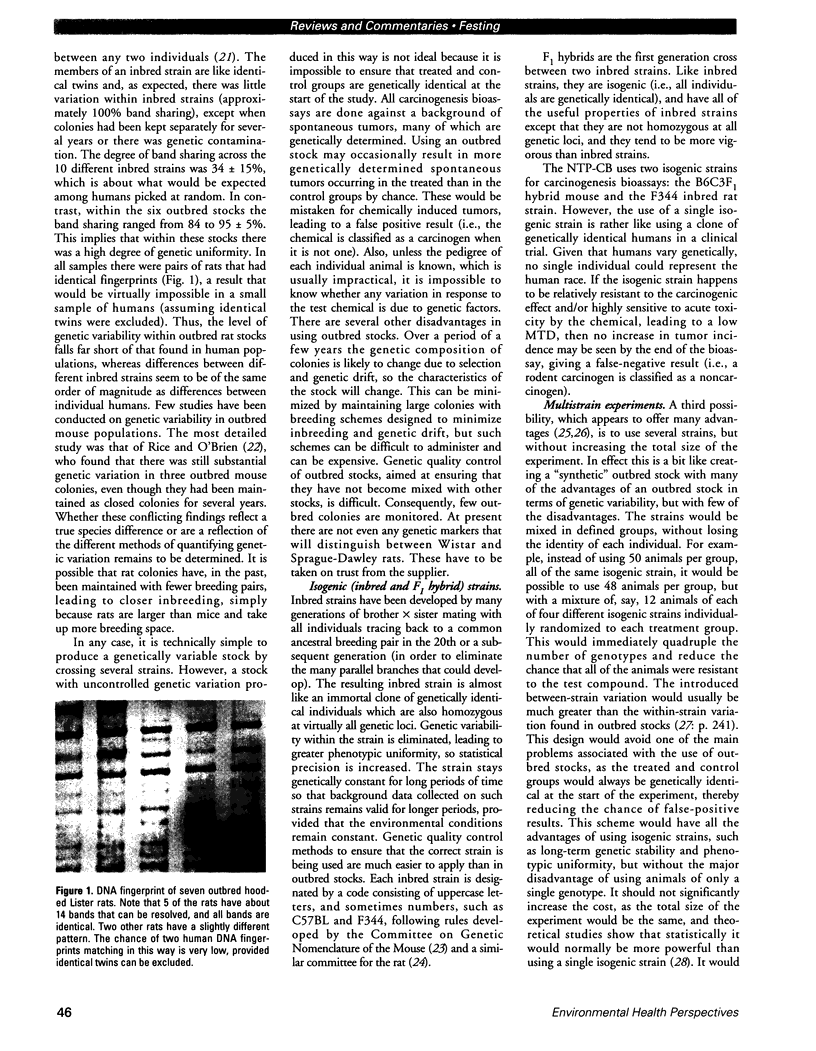
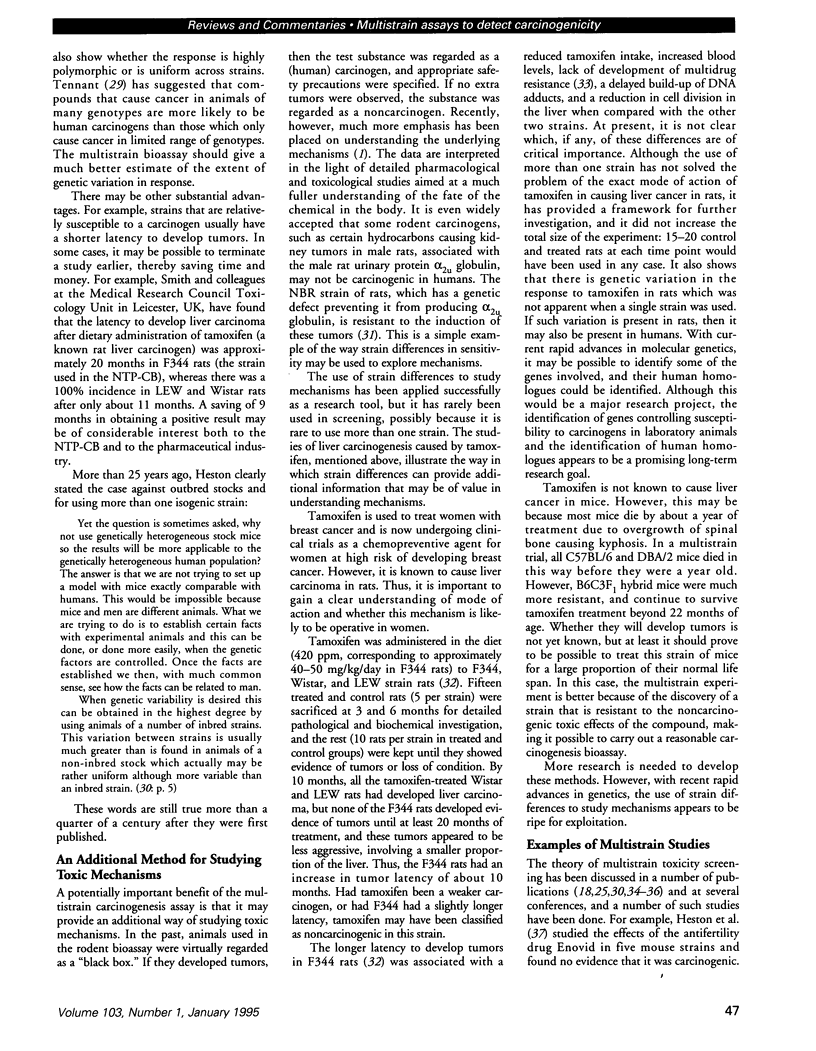
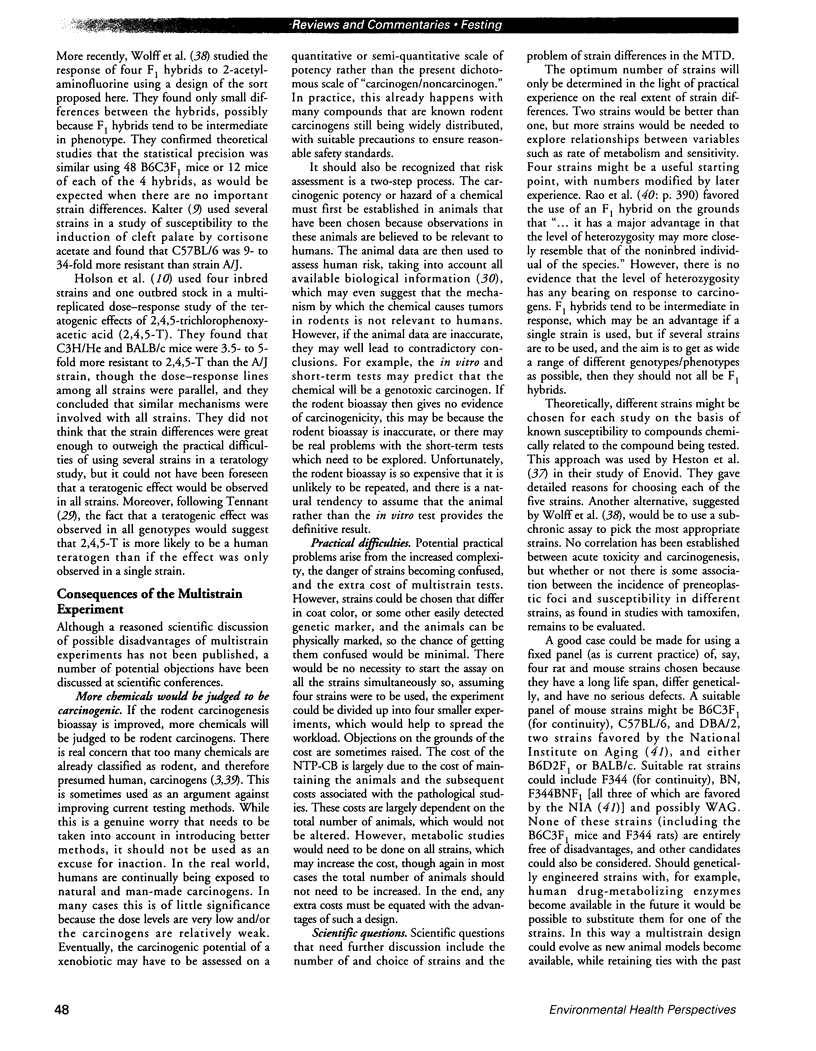
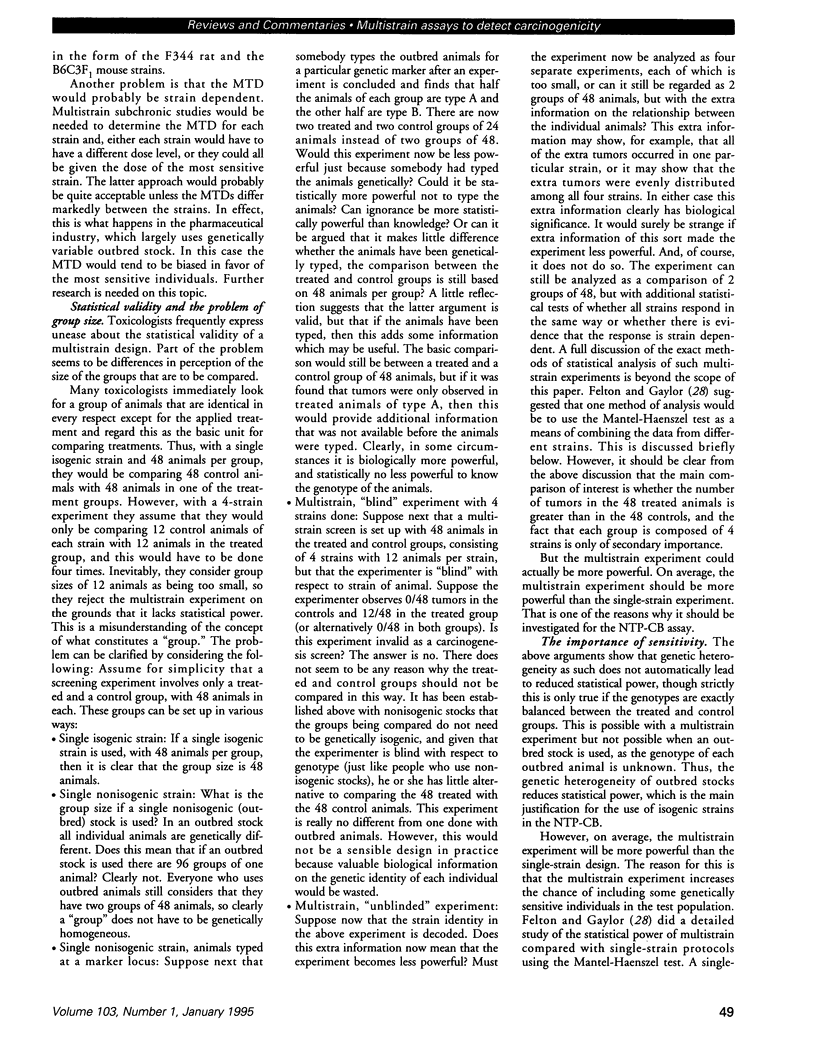
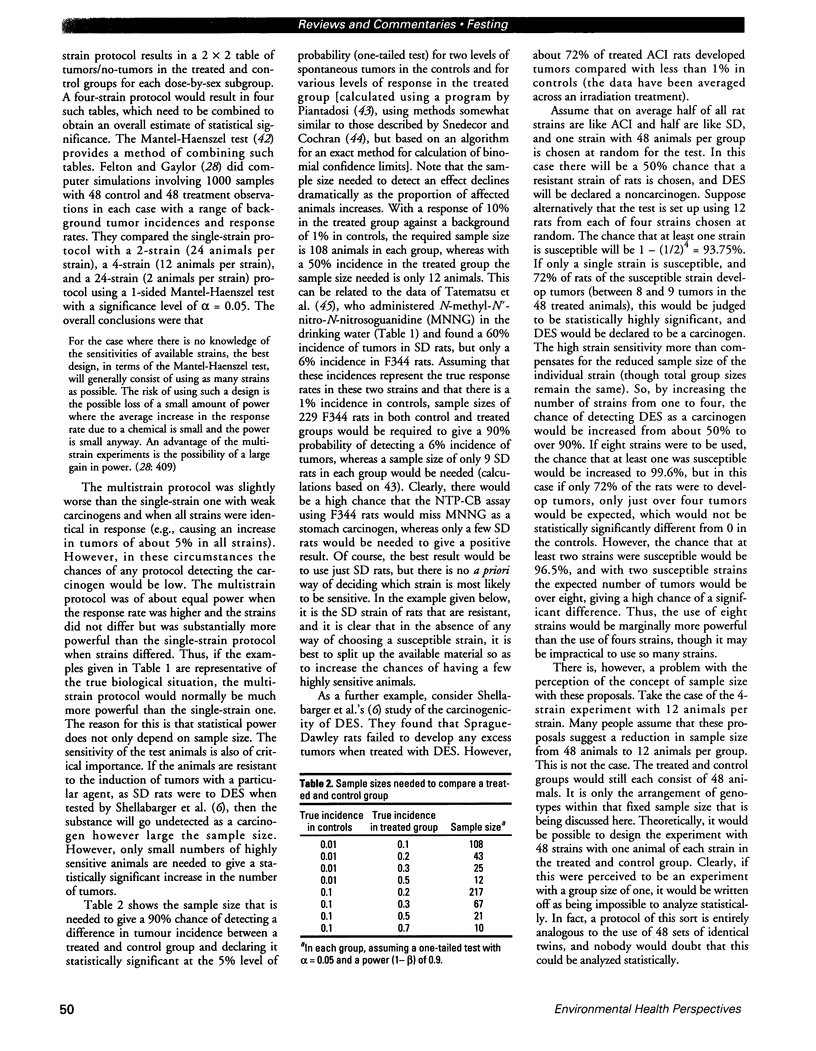
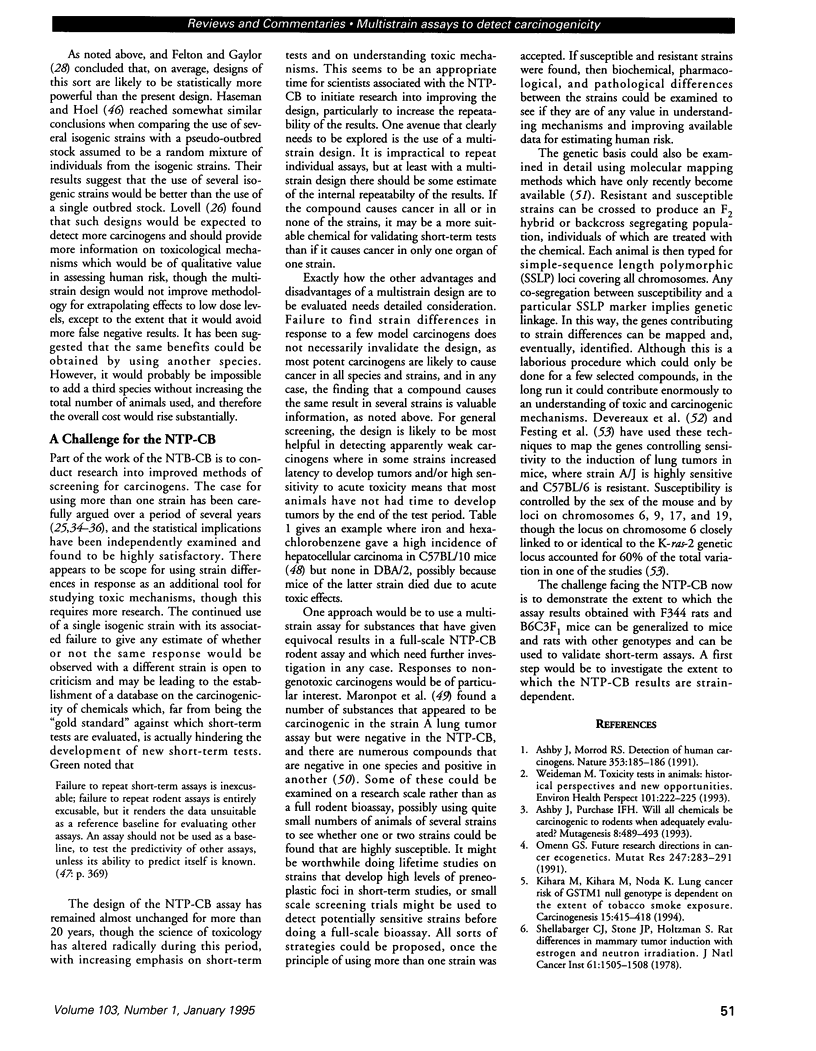
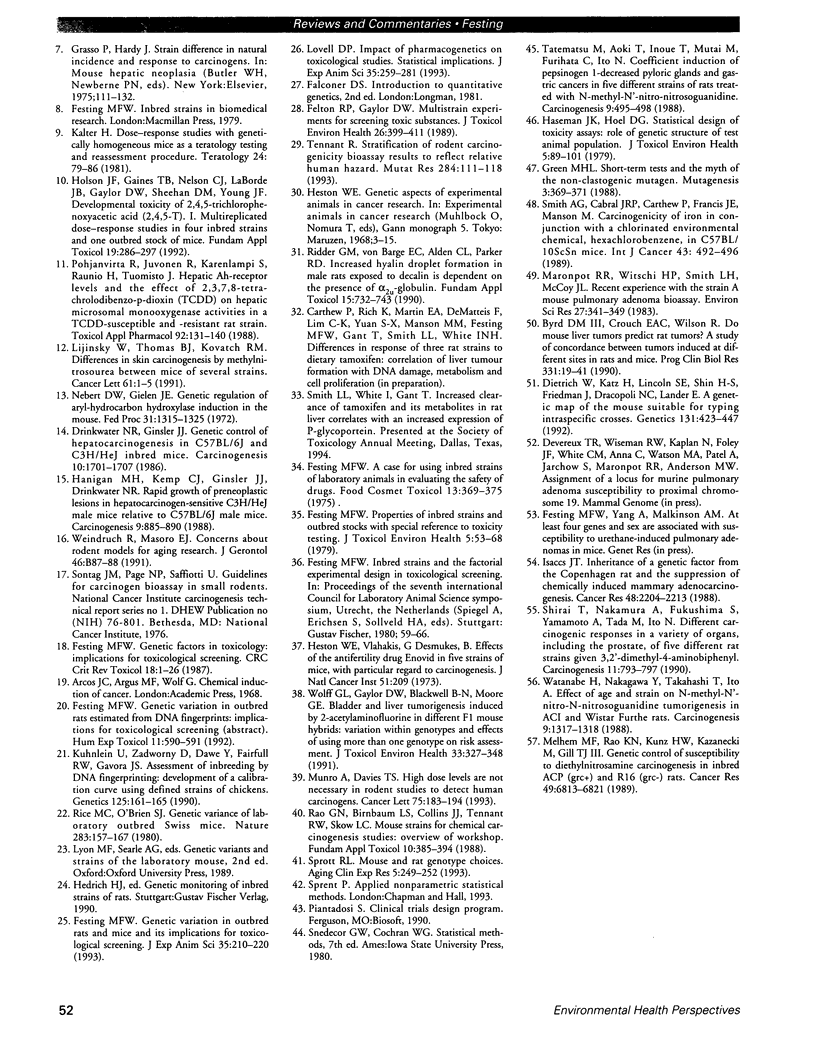
Images in this article
Selected References
These references are in PubMed. This may not be the complete list of references from this article.
- Ashby J., Morrod R. S. Detection of human carcinogens. Nature. 1991 Jul 18;352(6332):185–186. doi: 10.1038/352185a0. [DOI] [PubMed] [Google Scholar]
- Ashby J., Purchase I. F. Will all chemicals be carcinogenic to rodents when adequately evaluated? Mutagenesis. 1993 Nov;8(6):489–493. doi: 10.1093/mutage/8.6.489. [DOI] [PubMed] [Google Scholar]
- Byrd D. M., 3rd, Crouch E. A., Wilson R. Do mouse liver tumors predict rat tumors? A study of concordance between tumors induced at different sites in rats and mice. Prog Clin Biol Res. 1990;331:19–41. [PubMed] [Google Scholar]
- Dietrich W., Katz H., Lincoln S. E., Shin H. S., Friedman J., Dracopoli N. C., Lander E. S. A genetic map of the mouse suitable for typing intraspecific crosses. Genetics. 1992 Jun;131(2):423–447. doi: 10.1093/genetics/131.2.423. [DOI] [PMC free article] [PubMed] [Google Scholar]
- Drinkwater N. R., Ginsler J. J. Genetic control of hepatocarcinogenesis in C57BL/6J and C3H/HeJ inbred mice. Carcinogenesis. 1986 Oct;7(10):1701–1707. doi: 10.1093/carcin/7.10.1701. [DOI] [PubMed] [Google Scholar]
- Felton R. P., Gaylor D. W. Multistrain experiments for screening toxic substances. J Toxicol Environ Health. 1989;26(4):399–411. doi: 10.1080/15287398909531264. [DOI] [PubMed] [Google Scholar]
- Festing M. F. A case for using inbred strains of labroatory animals in evaluating the safety of drugs. Food Cosmet Toxicol. 1975 Jun;13(3):369–375. doi: 10.1016/s0015-6264(75)80302-6. [DOI] [PubMed] [Google Scholar]
- Festing M. F. Genetic factors in toxicology: implications for toxicological screening. Crit Rev Toxicol. 1987;18(1):1–26. doi: 10.3109/10408448709089855. [DOI] [PubMed] [Google Scholar]
- Festing M. F. Genetic variation in outbred rats and mice and its implications for toxicological screening. J Exp Anim Sci. 1993 Sep;35(5-6):210–220. [PubMed] [Google Scholar]
- Festing M. F. Properties of inbred strains and outbred stocks, with special reference to toxicity testing. J Toxicol Environ Health. 1979 Jan;5(1):53–68. doi: 10.1080/15287397909529725. [DOI] [PubMed] [Google Scholar]
- Green M. H. Short-term tests and the myth of the non-clastogenic mutagen. Mutagenesis. 1988 Sep;3(5):369–371. doi: 10.1093/mutage/3.5.369. [DOI] [PubMed] [Google Scholar]
- Hanigan M. H., Kemp C. J., Ginsler J. J., Drinkwater N. R. Rapid growth of preneoplastic lesions in hepatocarcinogen-sensitive C3H/HeJ male mice relative to C57BL/6J male mice. Carcinogenesis. 1988 Jun;9(6):885–890. doi: 10.1093/carcin/9.6.885. [DOI] [PubMed] [Google Scholar]
- Haseman J. K., Hoel D. G. Statistical design of toxicity assays: role of genetic structure of test animal population. J Toxicol Environ Health. 1979 Jan;5(1):89–101. doi: 10.1080/15287397909529728. [DOI] [PubMed] [Google Scholar]
- Heston W. E., Vlahakis G., Desmukes B. Effects of the antifertility drug enovid in five strains of mice, with particular regard to carcinogenesis. J Natl Cancer Inst. 1973 Jul;51(1):209–224. doi: 10.1093/jnci/51.1.209. [DOI] [PubMed] [Google Scholar]
- Holson J. F., Gaines T. B., Nelson C. J., LaBorde J. B., Gaylor D. W., Sheehan D. M., Young J. F. Developmental toxicity of 2,4,5-trichlorophenoxyacetic acid (2,4,5-T). I. Multireplicated dose-response studies in four inbred strains and one outbred stock of mice. Fundam Appl Toxicol. 1992 Aug;19(2):286–297. doi: 10.1016/0272-0590(92)90163-c. [DOI] [PubMed] [Google Scholar]
- Isaacs J. T. Inheritance of a genetic factor from the Copenhagen rat and the suppression of chemically induced mammary adenocarcinogenesis. Cancer Res. 1988 Apr 15;48(8):2204–2213. [PubMed] [Google Scholar]
- Kalter H. Dose-response studies with genetically homogeneous lines of mice as a teratology testing and risk-assessment procedure. Teratology. 1981 Aug;24(1):79–86. doi: 10.1002/tera.1420240109. [DOI] [PubMed] [Google Scholar]
- Kihara M., Kihara M., Noda K. Lung cancer risk of GSTM1 null genotype is dependent on the extent of tobacco smoke exposure. Carcinogenesis. 1994 Feb;15(2):415–418. doi: 10.1093/carcin/15.2.415. [DOI] [PubMed] [Google Scholar]
- Kuhnlein U., Zadworny D., Dawe Y., Fairfull R. W., Gavora J. S. Assessment of inbreeding by DNA fingerprinting: development of a calibration curve using defined strains of chickens. Genetics. 1990 May;125(1):161–165. doi: 10.1093/genetics/125.1.161. [DOI] [PMC free article] [PubMed] [Google Scholar]
- Lijinsky W., Thomas B. J., Kovatch R. M. Differences in skin carcinogenesis by methylnitrosourea between mice of several strains. Cancer Lett. 1991 Dec 9;61(1):1–5. doi: 10.1016/0304-3835(91)90069-t. [DOI] [PubMed] [Google Scholar]
- Lovell D. P. Impact of pharmacogenetics on toxicological studies. Statistical implications. J Exp Anim Sci. 1993 Sep;35(5-6):259–281. [PubMed] [Google Scholar]
- Melhem M. F., Rao K. N., Kunz H. W., Kazanecki M., Gill T. J., 3rd Genetic control of susceptibility to diethylnitrosamine carcinogenesis in inbred ACP (grc+) and R16 (grc) rats. Cancer Res. 1989 Dec 1;49(23):6813–6821. [PubMed] [Google Scholar]
- Monro A., Davies T. S. High dose levels are not necessary in rodent studies to detect human carcinogens. Cancer Lett. 1993 Dec 20;75(3):183–194. doi: 10.1016/0304-3835(93)90061-d. [DOI] [PubMed] [Google Scholar]
- Nebert D. W., Gielen J. E. Genetic regulation of aryl hydrocarbon hydroxylase induction in the mouse. Fed Proc. 1972 Jul-Aug;31(4):1315–1325. [PubMed] [Google Scholar]
- Omenn G. S. Future research directions in cancer ecogenetics. Mutat Res. 1991 Apr;247(2):283–291. doi: 10.1016/0027-5107(91)90023-h. [DOI] [PubMed] [Google Scholar]
- Pohjanvirta R., Juvonen R., Kärenlampi S., Raunio H., Tuomisto J. Hepatic Ah-receptor levels and the effect of 2,3,7,8-tetrachlorodibenzo-p-dioxin (TCDD) on hepatic microsomal monooxygenase activities in a TCDD-susceptible and -resistant rat strain. Toxicol Appl Pharmacol. 1988 Jan;92(1):131–140. doi: 10.1016/0041-008x(88)90235-9. [DOI] [PubMed] [Google Scholar]
- Rao G. N., Birnbaum L. S., Collins J. J., Tennant R. W., Skow L. C. Mouse strains for chemical carcinogenicity studies: overview of a workshop. Fundam Appl Toxicol. 1988 Apr;10(3):385–394. doi: 10.1016/0272-0590(88)90285-0. [DOI] [PubMed] [Google Scholar]
- Rice M. C., O'Brien S. J. Genetic variance of laboratory outbred Swiss mice. Nature. 1980 Jan 10;283(5743):157–161. doi: 10.1038/283157a0. [DOI] [PubMed] [Google Scholar]
- Ridder G. M., Von Bargen E. C., Alden C. L., Parker R. D. Increased hyaline droplet formation in male rats exposed to decalin is dependent on the presence of alpha 2u-globulin. Fundam Appl Toxicol. 1990 Nov;15(4):732–743. doi: 10.1016/0272-0590(90)90189-q. [DOI] [PubMed] [Google Scholar]
- Shellabarger C. J., Stone J. P., Holtzman S. Rat differences in mammary tumor induction with estrogen and neutron radiation. J Natl Cancer Inst. 1978 Dec;61(6):1505–1508. [PubMed] [Google Scholar]
- Shirai T., Nakamura A., Fukushima S., Yamamoto A., Tada M., Ito N. Different carcinogenic responses in a variety of organs, including the prostate, of five different rat strains given 3,2'-dimethyl-4-aminobiphenyl. Carcinogenesis. 1990 May;11(5):793–797. doi: 10.1093/carcin/11.5.793. [DOI] [PubMed] [Google Scholar]
- Smith A. G., Cabral J. R., Carthew P., Francis J. E., Manson M. M. Carcinogenicity of iron in conjunction with a chlorinated environmental chemical, hexachlorobenzene, in C57BL/10ScSn mice. Int J Cancer. 1989 Mar 15;43(3):492–496. doi: 10.1002/ijc.2910430325. [DOI] [PubMed] [Google Scholar]
- Sprott R. L. FRAR course on laboratory approaches to aging. Mouse and rat genotype choices. Aging (Milano) 1993 Aug;5(4):249–252. [PubMed] [Google Scholar]
- Tatematsu M., Aoki T., Inoue T., Mutai M., Furihata C., Ito N. Coefficient induction of pepsinogen 1-decreased pyloric glands and gastric cancers in five different strains of rats treated with N-methyl-N'-nitro-N-nitrosoguanidine. Carcinogenesis. 1988 Mar;9(3):495–498. doi: 10.1093/carcin/9.3.495. [DOI] [PubMed] [Google Scholar]
- Tennant R. W. Stratification of rodent carcinogenicity bioassay results to reflect relative human hazard. Mutat Res. 1993 Mar;286(1):111–118. doi: 10.1016/0027-5107(93)90006-2. [DOI] [PubMed] [Google Scholar]
- Watanabe H., Nakagawa Y., Takahashi T., Ito A. Effect of age and strain on N-methyl-N'-nitro-N-nitrosoguanidine tumorigenesis in ACI and Wistar Furth rats. Carcinogenesis. 1988 Jul;9(7):1317–1318. doi: 10.1093/carcin/9.7.1317. [DOI] [PubMed] [Google Scholar]
- Weideman M. Toxicity tests in animals: historical perspectives and new opportunities. Environ Health Perspect. 1993 Aug;101(3):222–225. doi: 10.1289/ehp.93101222. [DOI] [PMC free article] [PubMed] [Google Scholar]
- Wolff G. L., Gaylor D. W., Blackwell B. N., Moore G. E. Bladder and liver tumorigenesis induced by 2-acetylaminofluorene in different F1 mouse hybrids: variation within genotypes and effects of using more than one genotype on risk assessment. J Toxicol Environ Health. 1991 Jul;33(3):327–348. doi: 10.1080/15287399109531531. [DOI] [PubMed] [Google Scholar]




